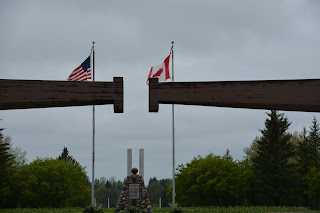Blog for June 2, 2015-
Straddling the 49th parallel, the border between Canada and the U.S., the International Peace Garden (IPG) is set in the Turtle Mountains, 1,451 acres in Manitoba and an adjoining 888 acres in North Dakota. When we were looking for a place to enter Manitoba from North Dakota, we noticed that there was a Provincial Park (Turtle Mountain) where we could camp that was the right distance from Minot, North Dakota and, there was this place called the International Peace Garden located right at the border. We had never heard of the International Peace Garden.
Then we noticed that the North Dakota license plates proclaimed that North Dakota was the “Peace Garden State.”
Yesterday, between the U.S. Customs station and the Canadian Customs, we saw the entrance to the Peace Garden which commemorates the friendship between the two countries on the longest unfortified border in the world. Today wasn’t the best day to visit the gardens because it was cold and rainy. But, no matter, the flowers were beautiful and the intent of the Gardens is inspiring.
Between the U.S. and Canada.
Entrance to the Peace Garden.
Lots of symbolism.
The cairn that contains the dedication plaque which reads: We two nations dedicate this garden and pledge ourselves that as long as men shall live we will not take up arms against one another.
View of the Formal Garden.
At the far end of the Formal Garden is the 120-foot Peace Tower which represents immigrants from the four corners of the world coming together with high hopes for the common purpose of peace.
Also at the far end is the Peace Chapel, the only building that straddles the border, which includes quotations etched in limestone walls.
Here are some of my favorites.
On the upper terrace are the Peace Poles, donated by the Japanese Government, which present the sentiment - May Peace Prevail On Earth - in many languages.
We think we were about three weeks too early to get the full benefit of the outdoor gardens. Here are a few of the lingering blooms.
Along the south side of the Formal Garden, the U.S. side, is the Interpretive Centre and a Conservatory which houses more than 6,000 cacti, succulents and orchids - a real treat.
Other interesting features are:
The Carillon Bell Tower, which chimes every 15 minutes.
The Floral Clock - 3,000 flowers are planted on the 18 foot clock and a GPS system (which wasn’t working) is supposed to enable accuracy.
The Historic Lodge is the oldest building in the IPG and it was built in 1937 by the Civilian Conservation Corps.
The North American Game Warden Museum is a joint initiative of Fish and Wildlife Officers of Canada and the United States. It is dedicated to officers who died in the line of duty.
Unfortunately it wasn’t open today, but we did look around outside where the memorial plaques are.
Some of the plaques are in appreciation.
We liked the sentiment on this one.
Here are two from Rhode Island.
The patio in back had the In Memorium listings by state/province or agency.
The most recent date was the one for Rhode Island, Seth Gillis, December 22, 2014, age 44. Does anyone know the details of his death?
Some states had no individuals to commemorate and there was a plaque that mentions that.
One of the most moving presentations was the 9/11 Memorial, constructed of steel salvaged from the ruins of the World Trade Center.
Listing of the First Responders who lost their lives on 9/11.
Along the Scenic Drive that joins the two sections of the park is the marker for the 49th parallel and commemorates the Commissioners that maintain the border.
There’s the border, as far as the eye can see.

























































http://www.providencejournal.com/article/20141229/NEWS/312299961
ReplyDeleteThanks, Suz. What a tragedy.
Delete